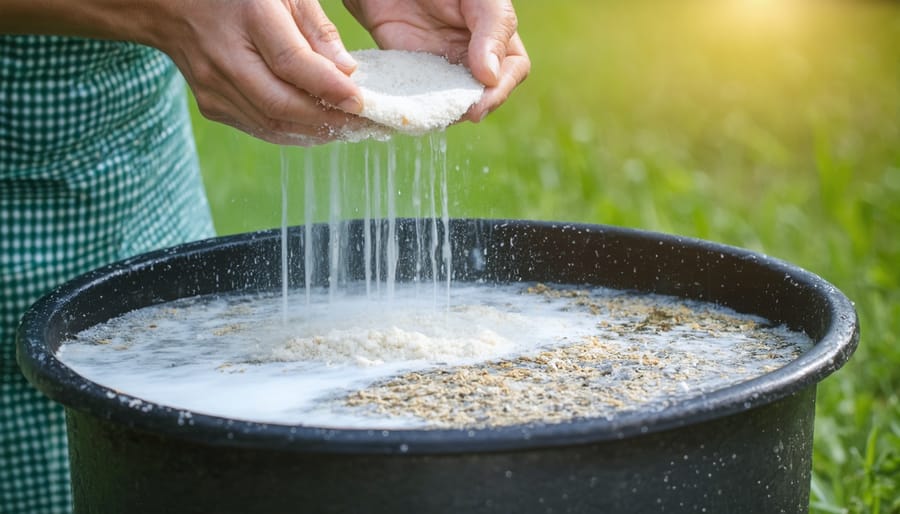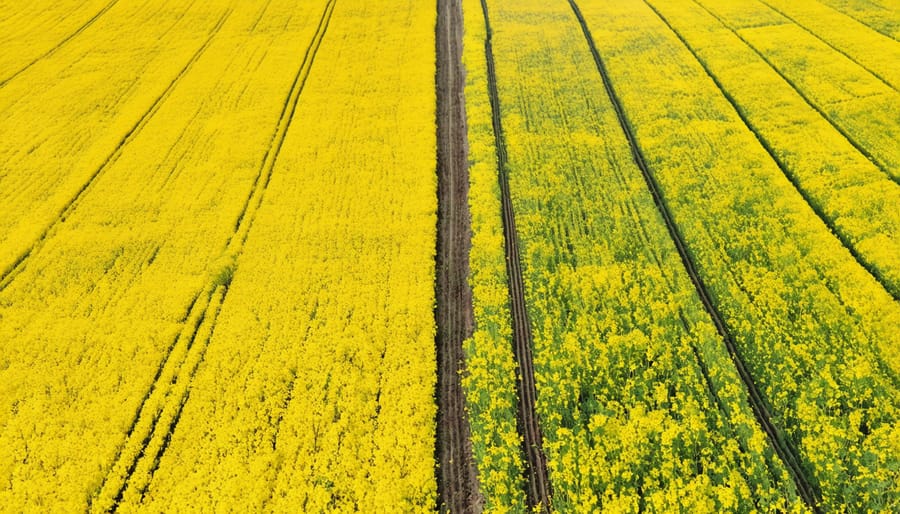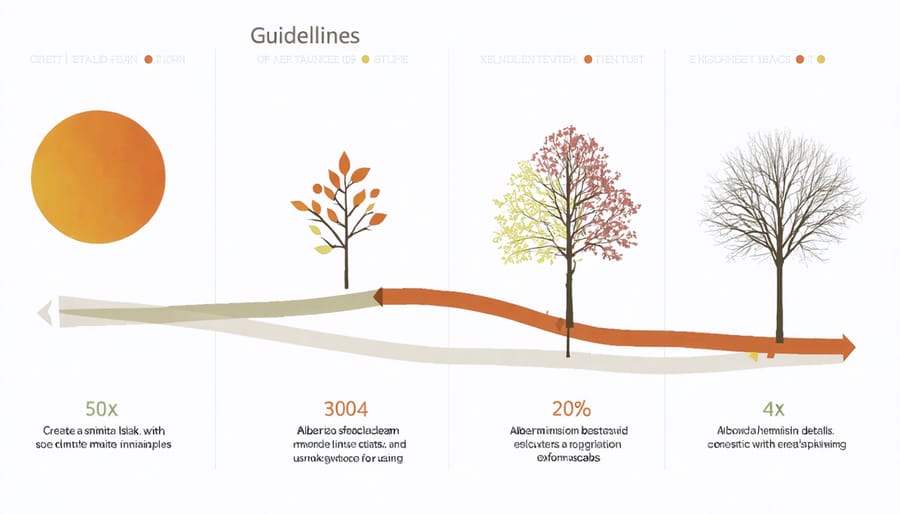Transform your garden’s pest management with JADAM’s ultra-low-cost organic pest control methods, developed by Korean natural farming pioneer Youngsang Cho. Mix indigenous microorganisms with local plant materials to create potent solutions at 1/100th the cost of commercial organic pesticides. Harness naturally occurring bacteria, fungi, and minerals from your own soil to build robust plant immunity while maintaining ecological balance.
JADAM’s system revolutionizes traditional organic farming by empowering farmers to produce their own inputs using readily available materials. This method has gained significant traction across Canadian farms, particularly in Alberta’s market gardens, where growers report up to 80% reduction in pest management costs while maintaining or improving crop yields.
Unlike conventional organic approaches that rely on purchased inputs, JADAM’s philosophy centers on self-sufficiency and working with nature’s existing defense mechanisms. The system’s effectiveness stems from its focus on soil microbial health and plant-microbe relationships, creating a sustainable ecosystem that naturally suppresses pest populations and plant diseases.
The JADAM Philosophy: Beyond Basic Organic Control
JADAM’s philosophy extends far beyond simply replacing chemical pesticides with organic alternatives. At its core, JADAM embraces the principle that farming should be both environmentally sustainable and economically viable for farmers. This Korean-developed approach aligns remarkably well with Canadian organic farming practices, particularly in its emphasis on using locally available materials and working in harmony with natural ecosystems.
The system builds on three fundamental principles: simplicity, affordability, and effectiveness. Unlike some organic farming methods that can be complex and costly, JADAM encourages farmers to create their own inputs using materials found on or near their farms. This self-reliance aspect resonates strongly with Canadian farmers who often face challenging economic conditions and remote locations.
What sets JADAM apart is its focus on soil microorganisms and plant immunity. Rather than just treating symptoms, the method strengthens plants’ natural defense mechanisms through enhanced soil health. This approach is particularly relevant for Alberta’s diverse growing conditions, where robust plant health is crucial for surviving environmental stresses.
JADAM also emphasizes community knowledge-sharing and adaptation to local conditions. Canadian farmers using these methods often modify traditional JADAM recipes to work with locally available materials, creating a uniquely Canadian interpretation of these Korean techniques. This flexibility makes JADAM particularly appealing to organic farmers looking to reduce input costs while maintaining certification standards.
The philosophy encourages farmers to observe and understand their specific ecosystem, making it well-suited to Canada’s varied agricultural regions. By focusing on preventive measures and building resilient farming systems, JADAM offers a sustainable path forward for Canadian organic agriculture.
Creating Your Own JADAM Solutions
Essential Materials for Alberta Farmers
Most JADAM ingredients can be sourced right here in Alberta, making it an accessible approach to natural pest control secrets. Essential materials include sea salt from local bulk suppliers, pine needles from our abundant forests, and mineral-rich soil from undisturbed areas. You’ll need basic tools like a 20L bucket, a high-speed blender or food processor, and a fine-mesh strainer.
For fermentation processes, source organic brown sugar or molasses from Alberta’s natural food stores. Local hardwood vinegar can be obtained from artisanal producers or made using maple or birch wood. Agricultural lime and sulfur are available at farm supply stores throughout the province.
Storage containers are crucial – food-grade plastic drums (60-200L) work well for larger batches. A simple pH meter helps monitor fermentation, while a basic thermometer ensures optimal conditions. Many Alberta farmers find success using regular garden sprayers for application, though backpack sprayers offer better coverage for larger areas.
Remember to source clean water, preferably from a well or filtered source, as chlorinated water may affect fermentation.

Step-by-Step Mixing Process
Creating JADAM solutions is straightforward when you follow these clear steps. Start by gathering your materials: a 200L food-grade drum, clean water, and your chosen organic materials.
For the basic JADAM solution:
1. Fill your drum with 180L of water, leaving space for additional ingredients
2. Add your organic materials (approximately 20L)
3. Secure the lid but don’t seal it completely to allow for fermentation
4. Store in a shaded area at 15-25°C
When making JADAM Sulfur Solution:
1. Mix 1kg of sulfur powder with 1L of water-soluble potassium
2. Heat the mixture to 200°C while stirring continuously
3. Cool completely before adding to 20L of water
4. Let it settle for 24 hours before use
For JADAM Microorganism Solution (JMS):
1. Collect leaf mold from healthy forest soil
2. Mix 1 part leaf mold with 10 parts water
3. Add 1kg of brown sugar per 10L of solution
4. Ferment for 5-7 days in a cool, dark place
5. Strain before use
Tips for success:
– Use rainwater when possible for better results
– Monitor fermentation daily
– Keep detailed records of your mixtures
– Test small batches before scaling up
– Store solutions in a cool, dark place
Remember that these solutions are living products. They may smell earthy and develop beneficial microorganisms during fermentation. Always wear protective gear when handling concentrated solutions and dilute according to crop-specific recommendations.
Real Results: Alberta Success Stories
The growing community of JADAM practitioners in Alberta is achieving remarkable Alberta organic pest management success through innovative applications of this Korean natural farming method.
Sarah McMillan, who operates a 160-hectare mixed vegetable farm near Lacombe, has been implementing JADAM solutions for three years. “We’ve reduced our pest control costs by 70% while maintaining crop quality,” she reports. McMillan’s notable achievement includes successfully managing cabbage moths using JADAM’s sulfur-lime solution, resulting in a 40% increase in marketable cabbage yield compared to previous seasons.
In the Peace Country region, Tom Anderson’s 400-hectare grain operation demonstrates JADAM’s effectiveness in larger-scale farming. Anderson’s implementation of JADAM liquid fertilizer and pest solutions has led to a 30% reduction in input costs while maintaining consistent yields. “The beauty of JADAM is its simplicity and affordability,” Anderson explains. “We’re creating effective solutions using local materials and seeing real results.”
Near Medicine Hat, the Weber Family Farm has tackled persistent aphid problems in their greenhouse operation using JADAM herbal solutions. “We noticed an 85% reduction in aphid populations within two weeks of application,” shares Maria Weber. Their success has inspired five neighboring farms to adopt similar practices.
The Sustainable Farming Collective in Red Deer has documented significant improvements in soil health and pest resistance across their member farms. Their three-year study shows that farms using JADAM methods experienced an average 45% reduction in pest-related crop losses while improving soil organic matter content by 2.5%.
These success stories highlight JADAM’s adaptability to Alberta’s diverse growing conditions. The method’s emphasis on locally sourced materials and simple preparation techniques has made it particularly attractive to farmers looking to reduce costs while maintaining productive, healthy crops. As more Alberta farmers share their experiences, the community’s collective knowledge continues to grow, adapting Korean natural farming principles to local conditions and challenges.

Common Pests and Their JADAM Solutions
Field Crop Protection
When it comes to protecting field crops like canola, wheat, and pulses, JADAM solutions offer effective and economical options that align well with integrated pest management strategies. Prairie farmers have found success using JADAM sulfur solution for managing fungal diseases in grain crops, particularly during wet seasons. The solution, made by combining elemental sulfur with potassium hydroxide, provides broad-spectrum protection against common pathogens.
For grasshopper control, many Alberta farmers report positive results using JADAM’s herbal solutions made from local plants like yarrow and wormwood. These botanical preparations are particularly effective when applied during the early nymph stages, helping protect emerging crops during critical growth periods.
Oil-based JADAM sprays, created using locally sourced canola oil, have proven effective against various grain pests. These sprays work by coating insects and disrupting their breathing mechanisms while being gentle on beneficial insects when properly diluted.
For soil-borne diseases affecting pulse crops, JADAM’s indigenous microorganism (JMS) solutions have shown promise in building natural resistance. These can be made using local soil from healthy forest areas, making them both cost-effective and regionally adapted.
Remember to adjust application rates based on crop stage and weather conditions, and always conduct small-scale trials before widespread implementation. Many successful JADAM practitioners in Western Canada apply treatments preventatively, especially during high-risk periods for disease development.
Market Garden Applications
Market gardens in Canada benefit greatly from JADAM’s organic pest control methods, particularly in protecting high-value crops like tomatoes, leafy greens, and berry plants. For greenhouse operations, diluted JADAM sulfur solution has proven effective against powdery mildew, a common challenge in controlled environments. Apply the solution during early morning hours to avoid leaf burn and ensure optimal absorption.
For outdoor vegetable plots, JADAM herbal solutions work exceptionally well. Alberta growers have reported success using local plants like stinging nettle and horsetail to create protective sprays. These solutions are particularly effective for controlling aphids on brassicas and protecting root vegetables from soil-borne pests.
Small-scale fruit producers can implement JADAM methods by creating specialized solutions for different growing seasons. Spring applications focus on preventing early-season insects, while summer treatments target fungal issues common in humid conditions. Many market gardeners combine JADAM sprays with companion planting for enhanced protection.
For season extension techniques, which are crucial in our shorter Canadian growing season, JADAM solutions can be safely used in combination with row covers and cold frames. The natural ingredients pose no risk to protective materials and help maintain optimal growing conditions.
Cost-effectiveness is another advantage for market gardeners, as most JADAM inputs can be sourced locally or produced on-site, significantly reducing operational expenses while maintaining organic certification standards.
Seasonal Application Guide
In Alberta’s varied climate, timing your JADAM applications is crucial for maximum effectiveness. Spring applications should begin when soil temperatures consistently reach 5°C, typically in late April to early May. This timing aligns with pest emergence and allows the solutions to work preventatively before major issues arise.
During the growing season (June to August), apply JADAM solutions every 10-14 days in normal conditions. However, adjust this schedule based on weather patterns and pest pressure. After heavy rainfall (over 25mm), reapply within 2-3 days to maintain protection. On particularly hot days (above 28°C), apply early morning or evening to prevent solution evaporation and protect beneficial insects.
For greenhouse operations, maintain a regular 7-10 day application schedule throughout the year, adjusting concentration levels based on humidity and temperature conditions. In high tunnels, ventilation is crucial during application to prevent solution concentration.
Fall applications are important for overwintering preparation. Continue treatments until temperatures consistently drop below 5°C, usually late September to early October in most Alberta regions. This helps reduce overwintering pest populations and strengthens plants before dormancy.
Weather considerations:
– Avoid application during rain or when rain is expected within 6 hours
– Apply in wind speeds below 16 km/h to ensure even coverage
– Maintain solution temperature above 10°C for optimal effectiveness
– During drought conditions, increase application frequency by 25%
Store prepared JADAM solutions in a temperature-controlled environment between 10-20°C for maximum shelf life. For winter storage, ensure solutions don’t freeze by keeping them in insulated spaces or heated storage areas.

Adopting JADAM organic pest and disease control methods offers Canadian farmers a sustainable, cost-effective approach to crop protection that aligns with our country’s commitment to environmental stewardship. By implementing these techniques, you’re not just protecting your crops – you’re investing in soil health and biodiversity while reducing dependence on expensive commercial inputs.
Start small by experimenting with basic JADAM solutions on a test plot, carefully documenting results and adjusting recipes to suit your specific conditions. Connect with local organic farming groups and agricultural extension services to share experiences and learn from others who are implementing these methods. Remember that success with JADAM is a journey of continuous learning and adaptation.
As you move forward, focus on developing a systematic approach to pest monitoring and prevention. Build your JADAM toolkit gradually, starting with simple solutions and expanding as you gain confidence. The investment in time and learning will pay off through reduced input costs and improved crop resilience.
Together, we can build a stronger, more sustainable agricultural future for Alberta and beyond, one farm at a time.








